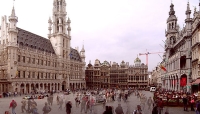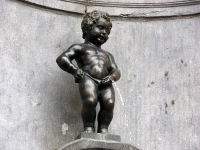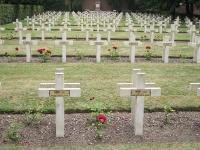Country guides

Things to do in Belgium
When it comes to world-class attractions and exciting sightseeing, Belgium packs a mighty punch for a country of such modest size. Visitors can drift from the cosmopolitan thrills of Brussels to the medieval charms of Bruges and the lesser-known historical treasures of Ghent. Along the way, they will discover welcoming people, great food, and some of Europe's finest beer and chocolate.
Belgium can be enjoyed year-round, though the countryside is at its most picturesque from spring through early autumn. The transport infrastructure is excellent, making it easy to explore beyond the cities. This isn't a country to experience from the confines of a tour bus. Visitors are best off wandering cobbled streets framed by medieval buildings, cycling along canals in the countryside, or spending an afternoon on Grand Place watching the world go by. Whatever mode they choose, time spent in Belgium rewards travellers with some of Europe's most delightful and often overlooked attractions.

Grand Place (Central Square)
The Grand Place is the beating heart of Brussels and has been since the Middle Ages. One of Europe's more beautiful squares, it lies at the centre of a maze of small cobbled street…
Grand Place (Central Square)
The Grand Place is the beating heart of Brussels and has been since the Middle Ages. One of Europe's more beautiful squares, it lies at the centre of a maze of small cobbled streets and is surrounded by richly decorated 17th century Baroque Guildhouses, various Neo-Gothic buildings and museums. But it is the town hall, a magnificent Gothic building, that dominates the square. Markets, flower stalls, and various events are held here and this is the place to get to grips with the essence of Brussels, perhaps over a local delicacy at a pavement cafe.
Website www.brussels.be/grand-place-brussels

Manneken-Pis
This distinctive statue of a naked boy urinating is thought to represent Brussels's irreverent spirit. History has many tales about its beginnings, with one especially whimsical st…
Manneken-Pis
This distinctive statue of a naked boy urinating is thought to represent Brussels's irreverent spirit. History has many tales about its beginnings, with one especially whimsical story having a witch curse a boy to pee for eternity after seeing him tinkle on her front door. The local tradition is to dress the tiny bronze statue at special occasions, and his wardrobe contains more than 800 costumes. The most expensive of them was a gift from Louis XV of France, though the statue has some modern outfits, too, such as a Mickey Mouse costume. As the cheeky fountain is one of the most popular attractions in Brussels, visitors can expect large crowds at most times of day, particularly during tourist season.
Website www.brussels.info/peeing-boy
Hotel de Ville
Brussels's town hall is rated as one of the most splendid civic buildings in Europe. The foundations were laid in 1402 and survived the bombing during World War II when most of the…
Hotel de Ville
Brussels's town hall is rated as one of the most splendid civic buildings in Europe. The foundations were laid in 1402 and survived the bombing during World War II when most of the other buildings on the Grand Place were destroyed. The facade is embellished with gargoyles and images of nobility, while atop the intricate 100 metre-high tower stands a fine statue of St Michael, patron saint of Brussels. Guided tours are available for a small fee and are well worth it to see the fine tapestries and miscellaneous works of art inside.
Palais Royal
Belgium's magnificent Royal Palace was finished in the 19th century and is the official residence of the Belgian Royal family. Today, the king and his family live at the Royal Pala…
Palais Royal
Belgium's magnificent Royal Palace was finished in the 19th century and is the official residence of the Belgian Royal family. Today, the king and his family live at the Royal Palace of Laeken on the outskirts of Brussels, with the city-based property hosting official functions and serving other ceremonial purposes. The palace is positioned in front of Brussels Park (itself well worth exploring) and directly opposite the modern Parliament building, as if symbolically representing the country's system of government: a constitutional monarchy. Tours are only possible in summer and commence after the National Holiday on 21 July. Inside are a multitude of historical artefacts and some impressive contemporary art, commissioned by Queen Paola of Belgium in 2002.
Website www.monarchie.be
Royal Museums of Fine Arts
Unmissable for art lovers, the Royal Museums of Fine Arts are Brussels's premier art museums and comprise the Musée Old Masters Museum, Musee Modern Museum, Musee Wiertz Museum, M…
Royal Museums of Fine Arts
Unmissable for art lovers, the Royal Museums of Fine Arts are Brussels's premier art museums and comprise the Musée Old Masters Museum, Musee Modern Museum, Musee Wiertz Museum, Musee Meunier Museum, Musee Magritte Museum and the new Musee Fin-de-Siecle Museum. The largest of them is the Old Masters Museum. Opened in 1887, it features the best collection of Flemish art in the world, with highlights including works by Van Dyck and over 20 paintings by Rubens. The Museum of Modern Art was opened in 1984 and includes fine examples from Belgium's best artists over the past century, plus modern legends such as Francis Bacon. The Magritte Museum is devoted to works of famous Belgian Surrealist Rene Magritte, and houses more than 200 of his works, while the new Musee Fin-de-Siecle Museum is dedicated to the 1900s when Brussels was the capital of Art Nouveau.
Website www.fine-arts-museum.be

Flanders Battlefield Tours
During World War I, the medieval town of Ypres in the Flanders region of Belgium was the epicentre of fighting on the Western Front, and the site of one of the bloodiest battles in…
Flanders Battlefield Tours
During World War I, the medieval town of Ypres in the Flanders region of Belgium was the epicentre of fighting on the Western Front, and the site of one of the bloodiest battles in the entire conflict. Flanders Battlefield Tours, run by an informed and knowledgeable group of Great War scholars, ensure that the memory of that lost generation is preserved and respected. The tour has been roundly celebrated for the vividness of the battle accounts, much of the information supplemented by personal artefacts, such as old maps, photographs, diary extracts and poems.
Visitors are sure to be awed, spending time in areas where, on average, every square metre of earth witnessed the death of 35 young men. This solemn, moving and important experience has been described by travellers as the best of its kind in Europe.
Website www.ypres-fbt.com


